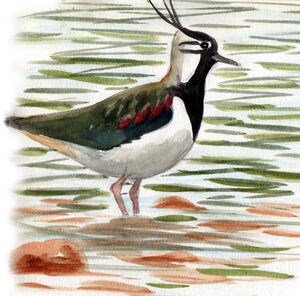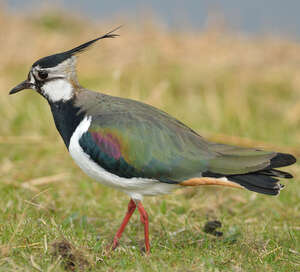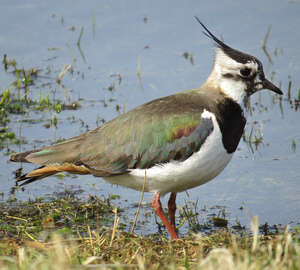Northern Lapwing
Vanellus vanellus - Vanneau huppé
Identification
The adult Northern Lapwing is easily identified. It is a medium-sized wader with dark green upper parts and white undersides. Most noticeably, it has a black and white head with a long, erect black crest perched at the back of the crown. There is little sexual dimorphism; the male's nuptial crest is longer and has more black on its face, while the female's face is less black with a white throat blotched with black. During the inter-nuptial period, however, distinguishing the two sexes is much harder, as the black feathers on the head have dulled. The adult also features a sharply contrasted black and white breast band and rust-brown under-tail coverts. In winter, the green feathers on the upper parts have a light beige edge, giving the plumage a scaled appearance. The crest is shorter and the head has a tinge of rufous to it. Chicks are covered with cryptic grey-beige down, marked with black, with a white neck and underside. Juveniles resemble adults, but have a less distinct head pattern, shorter crest, duller and more chamois-beige mottled upper parts, and less sharply defined breast band. In flight, the contrast between the dark upper parts and the white underside stands out, particularly when the birds are in groups and perform coordinated aerobatics. From a distance this appears as a group of flashing lights, black when the birds are facing away and white when facing towards. Up close, the upper parts are not entirely dark; with a white base of the tail and white at the wing tip. From underneath, the black and white body, wings and tail are prominent, and the oddly shaped wings, wide and rounded, give the Northern Lapwing a unique silhouette when in flight.
Subspecific information monotypic species
Foreign names
- Vanneau huppé,
- Avefría europea,
- abibe-comum,
- Kiebitz,
- bíbic,
- Kievit,
- Pavoncella,
- tofsvipa,
- Vipe,
- cíbik chochlatý,
- čejka chocholatá,
- Vibe,
- töyhtöhyyppä,
- fredeluga europea,
- Vepja,
- czajka (zwyczajna),
- ķīvīte,
- priba,
- Чибис,
- タゲリ,
- 凤头麦鸡,
- นกกระแตหงอน,
- 小辮鴴〔鳳頭麥雞〕,
Voice song and call
The Northern Lapwing is not stingy with its voice, and this is true for all seasons since it is a gregarious bird. It is particularly vocal in its reproductive locations as a result of its territoriality at this time. The usual call is a small phrase that can be translated as criarrh wewe criouit ouit ouit and variants on this theme. The alarm call is a high and grating hiairrhhh, often followed by ket ket ket ket ket.... The loud wing-beatings accompanying the display flight serve as territorial signals. The flight call is a wouiah, a contact between individuals, for example during nocturnal migration.
Habitat
The Northern Lapwing breeds in a wide variety of open, wet or dry habitats, with sparse or rare grass cover, or even bare ground, as long as its nesting ground is exposed so it can detect danger from above.
Behaviour character trait
What is striking about the Northern Lapwing is the contrast between the breeding period during which couples are territorial and nest isolatedly or in loose small colonies, and the inter-nuptial period during which a strong gregariousness is the rule.
The lapwings then enjoy the company of their peers. Groups of several thousand lapwings are common. Another important trait is the occasional polygamy of the males. Birds of the World gives the example of Norway where locally polygamy covers 20 to 40% of males, which results in a part of the adult males not being able to pair due to the lack of females. One can imagine under these conditions that the polygamous males provide an advantage to the species, maybe due to the quality of their genes which would be expressed by a better allure to the females. Finally, it has been proven that the female lapwing can lay an egg in the nest of another wader species such as the Black-tailed Godwit or the Knot. This is very original within this group of birds.Flight
The flight of the Northern Lapwing is a typical lapwing flight with relatively slow wing-beat in comparison to other Charadriiformes like plovers who have much quicker and more energetic wing-beat.
A lapwing cannot outrun a plover. Yet, though not very speedy, the lapwing is still very agile in flight. The display flight, with dives and ascents, is spectacular. Spectacular too are the formations of the birds in the sky as a group, for example after the intervention of a raptor such as a falcon, perfectly synchronised between individuals. The group behaves like one single organism.Dietfeeding habits
The Northern Lapwing is insectivorous throughout the year. It spots preys present at the surface of the ground by sight.
For those present near the surface, it searches with its beak and finds them by touch. In shallow waters, it uses the trembling foot method. It agitates its foot in the water, which causes a reaction of the preys that allows it to locate them. It can also feed at night, especially by full moon. Its regiment includes oligochaetes, insects and their larvae, for example larvae and imagoes of tipulid diptera, Coleoptera, ants, crickets, also spiders, millipedes, small mollusks gastropods, etc. At night, it hunts anecics, these earthworms that come to the surface in the darkness.Reproduction nesting
The breeding season runs from March to July depending on the local climate and latitude. The season starts with the couple settling in and exhibiting territorial behaviour from the male, who performs acrobatic aerial displays with dives, sudden acceleration followed by quick rises, erratic trajectories and cries.
He also makes a distinct woup woup woup... sound with his wings. The nest is a shallow depression of the ground with some vegetation loosely placed in it so as to give the brooding partner a good view of the surroundings. The female lays 4 pale brown, black-spotted eggs, which are incubated by both parents for 3 to 4 weeks. The chicks are nidifugous and are covered with a beige, black-spotted down, which is very cryptic against the sandy ground. They are raised by both the parents. They can fly at 35-40 days. If the first clutch is lost, which is common, there can be a replacement clutch. Occassionally, a second normal clutch is possible.Geographic range
The Northern Lapwing breeds throughout the Eurasian continent, from the European Atlantic coast to northeastern China and the Pacific coast in the Russian Amur region, in temperate and boreal latitudes. Its range reaches as far north as Scandinavia on one side and as far south as Spain, Turkey, northern Iran and Kirghizstan on the other. It winters largely south of its summer range, from western Europe and its offshore islands all the way to southeastern China, including the Mediterranean region, the Middle East and Northern India. It also reaches the Korean peninsula and southern Japan. It is present year-round in the European countries bordering the North Sea and the Atlantic Ocean.
Threats - protection
IUCN conservation status
concern
in the Wild
threatened
evaluated
In the past, the Northern Lapwing suffered from the intensification of human pressure on so-called 'improvable' wilderness spaces and the drainage of wetlands. This pressure continues to be a problem today, in particular the ploughing of meadows for agricultural cultivation, since animal rearing is less profitable. The improvement of remaining meadows by rolling, drainage, or the application of inorganic fertilizers is another problem.
Sources of information
- IOC World Bird List (v15.1), Gill, F and D Donsker (Eds). 2025-12-07.
- Limicoles, gangas et pigeons d'Europe, Paul Géroudet (mise à jour Georges Olioso)
- Shorebirds, an identification guide to the waders of the world, Peter Hayman, John Marchant Tony Prater
- Birds of the World, The Cornell Lab of Ornithology
- BirdLife International, BirdLife International
- xeno-canto, Sharing bird sounds from around the world,
Other sources of interest
 Specification sheet created on
15/07/2023 by Jean François
Specification sheet created on
15/07/2023 by Jean FrançoisTranslation by AI Oiseaux.net
© 1996-2026 Oiseaux.net
- Accipitriformes
- Aegotheliformes
- Anseriformes
- Apodiformes
- Apterygiformes
- Bucerotiformes
- Caprimulgiformes
- Cariamiformes
- Casuariiformes
- Charadriiformes
- Ciconiiformes
- Coliiformes
- Columbiformes
- Coraciiformes
- Cuculiformes
- Eurypygiformes
- Falconiformes
- Galliformes
- Gaviiformes
- Gruiformes
- Leptosomiformes
- Mesitornithiformes
- Musophagiformes
- Nyctibiiformes
- Opisthocomiformes
- Otidiformes
- Passeriformes
- Pelecaniformes
- Phaethontiformes
- Phoenicopteriformes
- Piciformes
- Podargiformes
- Podicipediformes
- Procellariiformes
- Psittaciformes
- Pterocliformes
- Rheiformes
- Sphenisciformes
- Steatornithiformes
- Strigiformes
- Struthioniformes
- Suliformes
- Tinamiformes
- Trogoniformes



































